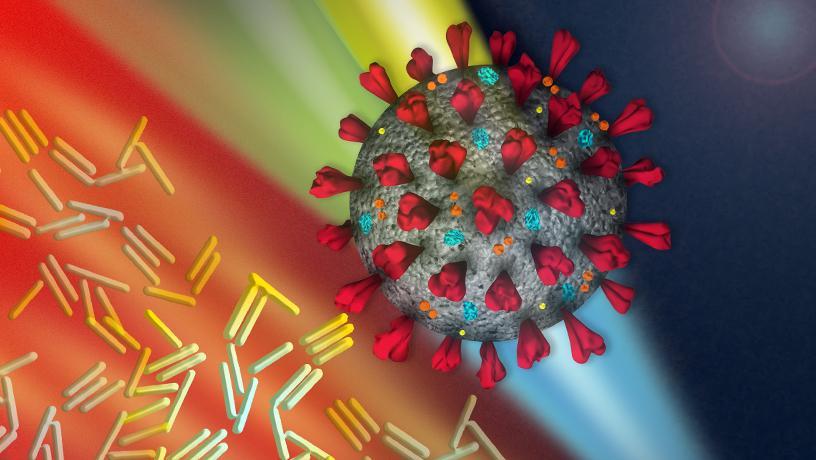New COVID-19 Rapid-test Technology Performs PCR Faster than Similar Tests on the Market
Researchers at Columbia Engineering and Rover Diagnostics team up to develop a low-cost, portable platform that gives RT-PCR results in 23 minutes that match laboratory-based tests
Media contact:
Holly Evarts, Director of Strategic Communications and Media Relations
347-453-7408 (c) | 212-854-3206 (o) | holly.evarts@columbia.edu
About the Study
Journal: Nature Nanotechnology
The study is titled “Multiplexed reverse-transcriptase quantitative PCR using plasmonic nanoparticles for point-of-care COVID-19 diagnosis .”
Authors are: Nicole R. Blumenfeld1,2†, Michael Anne E. Bolene1,2†, Martin Jaspan2, Abigail G. Ayers1, Sabin Zarrandikoetxea1,2, Juliet Freudman2, Nikhil Shah1,2, Angela M. Tolwani1,2, Yuhang Hu1,2, Terry Chern1, James Rogot2, Vira Behnam1, Aditya Sekhar1, Xinyi Liu1,2, Bulent Onalir2, Robert Kasumi1, Abdoulaye Sanogo1, Kelia Human1, Kasey Murakami1, Goutham Totapally1, Mark Fasciano2, Samuel K. Sia1* 1Department of Biomedical Engineering, Columbia University, 351 Engineering Terrace, 1210 Amsterdam Avenue, New York, NY 10027 2Rover Diagnostics, 3960 Broadway, 6th Floor, New York, NY 10032
The study was supported by. by a gift from Bing Zhao, and the NIH Rapid Acceleration of Diagnostics (RADx) Tech program as funded in whole or in part with Federal funds from the National Heart, Lung and Blood Institute; National Institute of Biomedical Imaging and Bioengineering; National Institutes of Health, Department of Health and Human Services, under Grant No. U54HL143541.
Competing Interests: Authors with affiliation to Rover Diagnostics, and S.K.S., had or have financial interest in Rover Diagnostics. All other authors declare no competing interests.

Infrared heating of plasmonic nanoparticles facilitates multiplexed reverse transcriptase quantitative PCR for rapid detection of SARS-CoV-2. Credit: Abigail Ayers/Columbia Engineering, Nicoletta Barolini
New York, NY—July 25, 2022—For more than 30 years, polymerase chain reaction (PCR) has been the gold standard in molecular diagnostic testing, detecting genetic material, such as those from a virus or from human DNA. But PCR, including reverse transcription polymerase chain reaction (RT-PCR), is mostly done at large, centralized laboratories, not in point-of-care (POC) settings, because its instrumentation is bulky, expensive, takes a long time for results, and requires trained technicians to run it. These limitations have led to a shortage of accurate POC diagnostics as well as bottlenecks in test results, particularly during the COVID-19 pandemic.
Researchers at Columbia Engineering and Rover Diagnostics announced today that they have built an RT-PCR platform that gives results in 23 minutes that match the longer laboratory-based tests—faster than other PCR tests on the market. It can be adapted to test for a broad range of infectious diseases including not just COVID-19 but also flu, strep, and other viruses that require fast diagnosis. Its targeted sensitivity is higher than other types of tests such as isothermal, antigen, and CRISPR. And, at just two pounds, the Rover PCR is easy to carry around and can be used by anyone.
“Our aim was to create a platform that can be used in locations where rapid turnaround results are critical, at pharmacies, transportation hubs, public events, and at companies screening employees coming back to work,” said Sam Sia, professor of biomedical engineering and Vice Provost for the Fourth Purpose and Strategic Impact at Columbia.
The system was co-developed with Rover Diagnostics, a biotech start-up co-founded in 2018 by Sia and serial tech entrepreneur Mark Fasciano, Rover’s CEO. The platform uses sample preparation techniques developed at Sia’s lab, combined with a new approach to thermal cycling, bypassing the standard approach of Peltier device—which heats the sample from outside the vial. Instead, Rover’s system uses a photothermal process—plasmonic hermocycling—that relies on nanoparticles irradiated by light to rapidly generate heat from inside.
The team successfully performed reverse-transcriptase quantitative PCR (RT-qPCR) in a reaction vessel containing all the PCR reagents. qPCR is the current gold-standard laboratory technique for identifying COVID infection. The technique provides quantification of infectious units, but it also poses a number of hurdles for point-of-care (POC) miniaturization.
In the study published today in Nature Nanotechnology, the researchers addressed these challenges by leveraging plasmonic nanoparticles—discrete metallic particles that respond to infrared light by releasing heat—to achieve real-time and multiplexed RT-qPCR on clinical specimens.
“This should really move the needle on delivering rapid and accurate molecular clinical diagnostics in decentralized settings,” said Fasciano, a computer scientist turned software and biotech entrepreneur. “Thermal cycling, so critical to DNA and RNA testing, can now be sped up and clinicians and patients alike won’t have to wait so long for results.”
The Rover team is moving forward with a commercial product that can detect COVID-19, its variants, and other infectious diseases.
